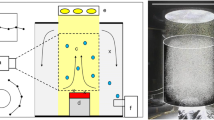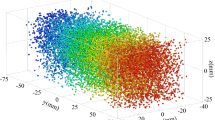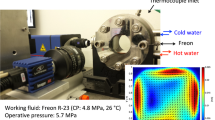Abstract
This paper presents the application of optical measurement techniques in dense-gas flows in a heavy-gas channel to determine planar two-component (2C) velocity profiles and two-dimensional (2D) temperature profiles. The experimental approach is rather new in this area, and represents progress compared with the traditional techniques based on thermocouple measurements. The dense-gas flows are generated by the evaporation of liquid nitrogen. The optical measurement of both the velocity and density profiles is accomplished by the implementation of particle image velocimetry (PIV) and background-oriented schlieren (BOS) systems. Supplemental thermocouple measurements are used as independent calibrations to derive temperatures from the density data measured with the BOS system. The results obtained with both systems are used to quantify the dilution behavior of the propagating cloud through a global entrainment parameter β. Its value agrees well with the results obtained by earlier studies.















Similar content being viewed by others
References
Britter RE (1987) Assessment of the use of cold gas in a windtunnel to investigate the influence of thermal effects on the dispersion of LNG vapour clouds. Engineering Department, Cambridge University, Cambridge, CUED/A-Aero/TR 14
Dalziel SB, Hughes GO, Sutherland BR (2000) Whole-field density measurements by ‘synthetic schlieren’. Exp Fluids 28:322–355
Fanneløp TK (1994) Fluid mechanics for industrial safety and environmental protection. Industrial safety series, no 3, Elsevier, Amsterdam, The Netherlands
Jensen O, Kunsch JP, Røsgen T (2001) PIV measurements in a heavy-gas cloud using ice-particle seeding. In: Kobayashi (ed) Proceedings of the 3rd Pacific symposium on flow visualization and image processing 2001 (PSFVIP-3), Maui, Hawaii, March 2001
Jensen OS (2003) Optical density and velocity measurements in cryogenic-gas flows. Switzerland ETH Z Diss. ETH, no. 15259
Køpf U (1972) Application of speckling for measuring the deflection of laser light by phase objects. Opt Comm 5:347–350
Kunsch JP, Fanneløp TK (1995) Unsteady heat-transfer effects on the spreading and dilution of dense cold clouds. J Haz Mat 43:169–193
Meier GEA (2002) Computerized background-oriented schlieren. Exp Fluids 33:181–187
Raffel M, Willert C, Kompenhans J (1998) Particle image velocimetry. Springer, Berlin Heidelberg New York
Richard H, Raffel M (2001) Principle and applications of the background oriented schlieren (BOS) method. Meas Sci Tech 12:1576–1585
Ruff M, Zumsteg F, Fanneløp TK (1988) Water content and energy balance for gas cloud emanating from a cryogenic spill. J Heat Mass Transfer 19:51–68
Scarano F (2002) Iterative image deformation methods in PIV. Meas Sci Tech 13:R1–R19
Vasil’ev LA (1971) Schlieren methods. Israel Program for Scientific Translations, Keter Publishing, New York Jerusalem London
Rodi W (1982) Turbulent buoyant jets and plumes. Pergamon Press, New York
Wernekink U, Merzkirch W (1987) Speckle photography of spatially extended refractive-index fields. Appl Opt 26:31–32
Willert CE, Gharib M (1991) Digital particle image velocimetry. Exp Fluids 10:181–193
Author information
Authors and Affiliations
Corresponding author
Appendix A
Appendix A
1.1 Determination of the entrainment coefficient
The dilution of the cloud is due to the entrainment of ambient air into the cloud, which can be modeled by an entrainment velocity proportional to the horizontal velocity averaged over the height of the heavy-gas layer, i.e.:
A mass and a momentum balance are formulated for a generic “differential element,” defined by a box delimited by an inlet and outlet vertical plane at two locations downstream of the release chamber and the top surface of the cloud propagating between both locations. Both equations are used to deduce β. For modeling purposes, the velocity u and the density ρ, which is actually deduced from the temperature Ta in the cloud, are averaged over the height H of the cloud. The free atmosphere is described by the ambient density ρae and the temperature Tae.
The mass balance for the “differential element” reads as follows:
For continuity considerations, the properties (i.e., gas constants and specific heats) of the entrained air and the dense-gas cloud, consisting mostly of nitrogen, are assumed to be the same, and the moisture content of the cloud is neglected. In this case we obtain:
The horizontal momentum balance for the differential element reads (Rodi 1982) as:
The LHS of Eqs. 7 and 8 are differentiated term by term respectively, and dH/dx is eliminated from both equations. In this case, the entrainment coefficient β can be expressed as a function of the temperature and the velocity gradients in the x direction, which can be obtained experimentally with sufficient approximation, i.e.:
with c1=u2+gH (1−Ta/Tae), c2=gH (Ta/Tae−0.5), and c3=c1−2u2. The last term on the RHS in Eq. 9 is related to friction at the ground surface and its value can be up to 30% of the value of the first term. The friction factor cf is derived from the local friction factor c′f=0.0592(Re x )−1/5 for a flat plate, which is averaged over the distance between the inlet and the outlet of the differential control volume. The value cf=0.0064 obtained is close to the value cf=0.0060 suggested by (Britter 1987) for dense-gas dispersion.
Rights and permissions
About this article
Cite this article
Jensen, O.S., Kunsch, J.P. & Rösgen, T. Optical density and velocity measurements in cryogenic gas flows. Exp Fluids 39, 48–55 (2005). https://doi.org/10.1007/s00348-005-0966-8
Received:
Revised:
Accepted:
Published:
Issue Date:
DOI: https://doi.org/10.1007/s00348-005-0966-8




